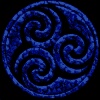The Art of Effective Invocation
 Section One: The Nature
of Invocation.
Section One: The Nature
of Invocation.
Before I get to heavily into this area of discussion, I feel it necessary
to provide a few definitions as I was trained to see them.
Invocation: To bring something "in" from "without".
During any ritual in which something is entreated, summoned, stirred or
called, to enter the ritual area for the purposes of lending its energies/influence
or guarding said ritual area.
Evocation: To draw something "out" from "within".
During any ritual in which you work with your higher selves, totems power
animals etc. within a ritual area.
Banishing: To release an energy called through invocation
into your ritual area. (also to remove any unwanted energies from the ritual
area prior to a ritual working, or removed from a place during an exorcism.
)
When performing a ritual that involves energies such as Deity, Elementals,
WatchTowers, etc., you can use the Pentagram to invoke them with greater
ease. For the purpose of ritual, all energies other than those within you,
the objects that you bring, and the immediate area you are in, are considered
to be "outside" a proper circle. Therefore, should you wish to work with
any other energies, you need to invite them "within" your ritual area.
These can be called upon to either Participate, Guard or simply Witness
the rite you are performing. But before that, they must be called into
the area through Invocation.
 Section Two: The Effective
use of the Pentagram During Ritual.
Section Two: The Effective
use of the Pentagram During Ritual.
The fundamentals of most traditional methods of invocations involve the
use of the pentagram (drawn in the air) as a method to call the energies
into your circle. When using the pentagram to invoke/banish energies you
need to think of how it looks to the being being summoned or banished.
To draw the energies in, you draw it clockwise to THEIR perspective, and
to banish them you draw it counter clockwise from their point of view.
Below are four depictions of the pentagram with elemental correspondences
drawn in and directions written for their proper use. These instructions
are given as if you are drawing the Pentagram in the Air before you. Inscribing
it onto an object is a different matter and a separate picture is included
below for marking an object with the pentagram (drawn pentagram)
|
|
|
|
|
|
|
|
|
|
|
|
The Pentagram can be used to invoke specific elemental energies, by beginning in the proper spot and moving in the proper direction. Its important to understand that these energies come when called and leave when banished properly. Improper summoning results in the wrong energies or none at all being summoned. Improper banishing however leads to the continued influence (and sometimes annoyance) of the energies that you have summoned. If you use an elemental type of circle casting you can use the pentagram to call these energies into your circle by beginning in that elements' corresponding location within the pentagram (as shown above) . Say you wanted to invoke the element of Earth, you would begin at the Earth point of the Pentagram (lower left) and move to Water and so on until back at Earth again. The same is true of the rest when drawing them in the Air. There is really only two uses for drawing the Pentagram on an object, to bless it (infuse it with divine energies) or to cleanse it (banish unwanted energies from it). For this purpose you can use the Pentagram shown above (drawn Pentagram) for blessing, and start at Spirit and move to Earth for banishing.
**NOTE**
Before summoning any of these energies, research them, learn all you can
about them through ancient legends and modern literature. If you work with
Totems or spirit guides, consult their wisdom aswell. Its better to know
what you are entreating into your sacred and safe space, after all you
would not want to call a trickster god who would like nothing better than
to see you fail, into an important healing ritual. A word of caution in
general: as a guideline, if you feel even remotely uncomfortable working
with a specific energy (deity/spirit, etc), DONT. You must be clear and
centered to effectivly perform ritual, and that unease will seep into your
ritual, bringing flaws into it where none existed before. Magick is a learned
art, not something that can be done safely with no knowledge at all. With
WitchCraft especially "thy powers wax as Wisdom waxes", so study learn
and formulate your own feelings about how it should be done.
This is no way is meant to say that traditional methods are not as effective
as ones you create yourself. On the contrary, they are often the most effective
methods (having already been refined and practiced for some time) once
the practitioner learns the nuances and finite details of the "how?" and
"why?" the rites are performed in that fashion. The Tradition I teach is
called "Foundationist Wicca", whos core tennet is that at the core of all
things called "Mysteries", lies the Truth of our relationship to the Gods
and to eachother. So study different techniques for all things, find the
common links between them and glean the Truth from that.
Coming Soon: PART 7!!!